Table of Contents
Introduction
What is sprinkler method of irrigation?
Sprinkler irrigation system involves the use of a pressurized pipe network in order to deliver water to sprinklers, nozzles, or jets that spray water into the air, which falls to the soil as an artificial rain.
By selecting the right nozzle size and pressure, a sprinkler can be controlled for the amount of water to be applied and the area to be covered.
What is sprinkler irrigation?
Sprinkler irrigation system can be defined as a pressurized system, in which water is distributed through a network of pipe lines to and in the field and applied via sprinkler heads or water applicators.
Types of Sprinkler Systems
What are the types of sprinkler irrigation system?
Sprinkler devices and sprinkler systems are available in many varieties. There are many different types, sizes, prices, and capabilities of sprinkler irrigation systems.
Here are some descriptions of the most common types:
1 . Portable (or Hand-Move) Sprinkler irrigation System
The system uses lateral pipelines with sprinklers positioned at regular intervals. This is a periodic move type of sprinkler irrigation system.
Oftentimes, lateral pipes are made of aluminum and come in sections of 20, 30, or 40 feet. Each joint of the pipe has a special quick-coupling connection.
Typically, sprinklers are mounted on a pipe riser so they can operate above the crop.
The riser of these types of sprinklers may be short in orchards so that they operate under the canopy of the trees.
Pipe couplings connect the risers to the lateral, where the lateral section length is determined by the sprinkler spacing.
Sprinkler laterals are installed in one location and used until the desired water application has been completed.
Following this, the lateral line is disassembled and moved to the next irrigation location.
Sprinkler systems of this type have a low initial cost, but a high labor requirement.
Most crops can be cultivated with this type of sprinkler irrigation system. However, crops like corn become difficult to irrigate as the crop starts to mature.
2. Solid Set and Permanent sprinkler irrigation Systems
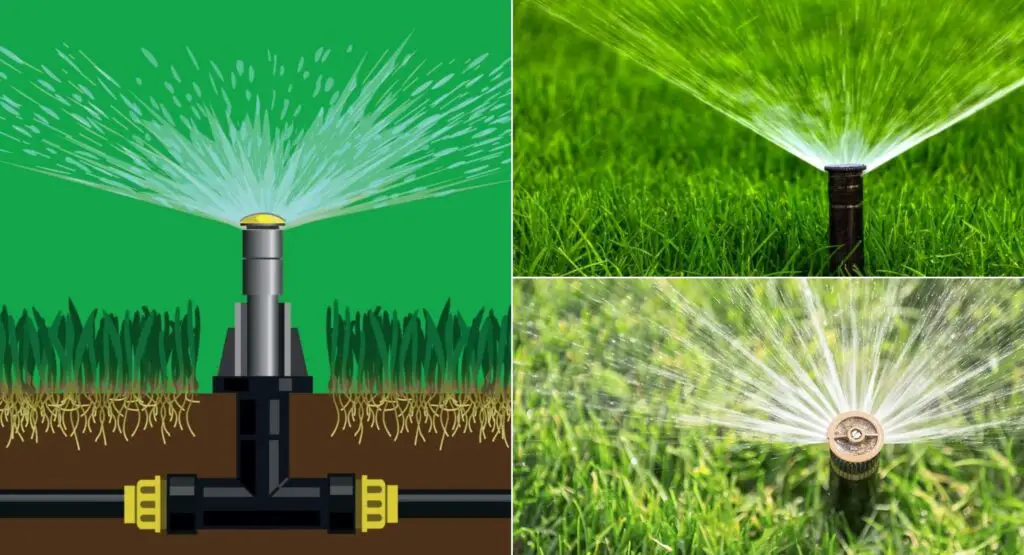
In this type of sprinkler irrigation system, a sprinkler irrigates from a fixed position.
For a solid set sprinkler irrigation system, the pipe laterals are moved into the field at the beginning of each irrigation season, and remain there until the season is over.
This is a permanent type of sprinkler irrigation system where the main supply pipes (generally PVC plastic pipes), laterals and sprinklers are burried in the soil.
Solid-set sprinkler irrigation systems are similar to hand-move lateral sprinkler irrigation systems, except that laterals are placed in sufficient numbers so that the pipe does not need to be moved during the cropping season.
Valves control the lateral irrigation, which directs water to the laterals irrigating at a specific moment.
In the solid set sprinkler irrigation system, labor is required at the beginning and the end of the irrigation season, but it is minimal during the irrigation period.
3. Side Roll sprinkler irrigation System / Wheel Line sprinkler irrigation System
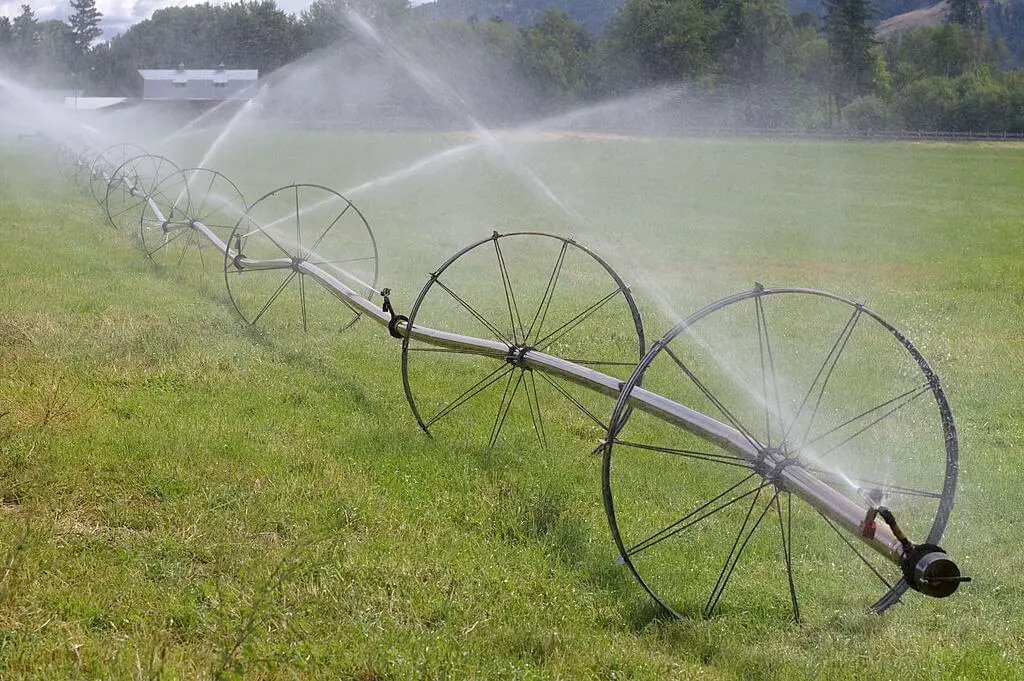
In side roll sprinkler irrigation, a pipe serves as the axle for the lateral line, which is mounted on wheels. This is a periodic move type of sprinkler irrigation system.
The radius of the wheel is chosen carefully so that when the laterals are moved, they clear the crop.
For rectangular fields, a side roll sprinkler irrigation system works best.
This sprinkler irrigation system is moved from one irrigation location to the other by the help of a drive unit. The drive unit typically is an air cooled diesel or gasoline powered engine placed mostly at the center of the laterals.
4. Traveling Gun sprinkler irrigation System
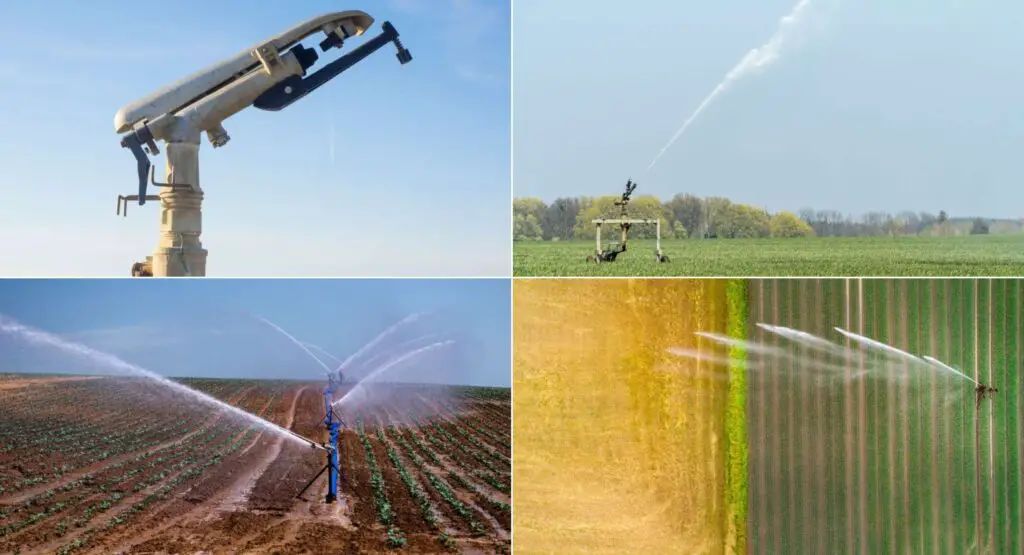
This type of sprinkler irrigation system uses high volume and high pressure sprinklers called “guns“. Water is fed to the gun by a flexible hose connected to the trailer or from a ditch the trailer passes through. This type of irrigation can also be termed as rain gun irrigation.
An operator may operate the gun in a fixed position for the specified length of time, then move it to the next irrigation location. However, the most popular application of this type of sprinkler irrigation system is continuous movement, where the gun sprinkles while moving.
In most cases, a part-circle sprinkler is used, operating through 80–90% of the circle so as to achieve maximum uniformity and allow the trailer to move forward on dry ground.
Despite the fact that these systems can be applied to most crops, their large droplets and high application rates are best suited to coarse soils with high intake rates and crops that provide good ground cover.
5. Center Pivot sprinkler irrigation system and Linear Move sprinkler irrigation systems

These type of sprinkler irrigation systems are a subset of continuous move lateral sprinkler irrigation system.
This type of sprinkler irrigation system has a center pivot system which consists of a single sprinkler lateral supported by a series of towers.
As the towers are self-propelled, the lateral rotates around a pivot point located at the center of the irrigated area.
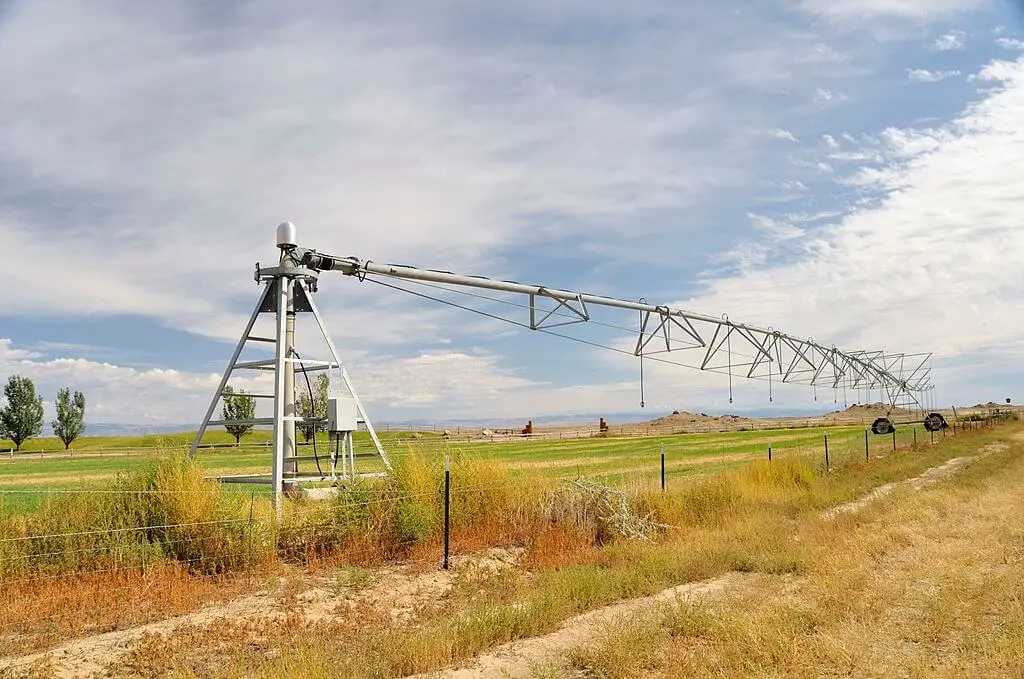
Circumnavigating through one complete circle can take anything from a half day to a few days.
In construction, a linear move sprinkler irrigation system is similar to the center pivot system, with the exception that neither end of the pipeline is fixed.
In linear move sprinkler irrigation method, the entire irrigation line travels down the field in a direction perpendicular to the lateral.

If the lateral is longer (in central pivot system), the end of the lateral will travel faster and the irrigated area will be larger. Therefore, to be able to apply an even amount of water, the water application rate must be increased accordingly as the distance from the pivot point increases.
For this type of sprinkler irrigation method, a variety of sprinkler products have been developed to better match soil characteristics, water requirements, and water application rates.
Center pivot sprinkler irrigation system leaves the corners of the field unirrigated since it irrigates in a circle.
In addition to being able to irrigate most field crops, center pivots sprinkler irrigation could also be used to irrigate trees and vines.
6. LEPA sprinkler irrigation Systems

In order to reduce energy consumption, lower system flow capacities, and maximize water use efficiency, many techniques have been developed.
Low Energy Precision Application (LEPA) systems are similar to linear move irrigation systems but are sufficiently different to warrant a separate mention.
In this type of sprinkler irrigation system, water is discharged through the lateral lines just above the ground surface into furrows through drop tubes and very low pressure orifices.
Drop tubes fitted with low pressure 5 – 10 psi application devices are used to apply water to the crop canopy near the ground surface.
In addition to this distribution system, microbasin land preparation is often used along with this irrigation method for improved runoff control.
For application efficiencies in the high 80s, good soil and water management is required. Soil types with high soil intake rates are preferred for this type of irrigation.
In order to prevent runoff or nonuniformity along a furrow, there should be adequate surface storage in the furrow micro-basins.
Requirements for sprinkler irrigation system
1 . Soil type
sprinkler irrigation is suitable for which soil ?
There is a wide range of soil types and topographic conditions that sprinklers can adapt to.
For instance, sprinkler irrigation works well on light sandy soils.
However, some soils may require special measures if the intake rate is less than 0.2 inches per hour.
Sprinklers are useful in soils that are too shallow for surface shaping or too variable for effective irrigation by surface irrigation.
2. Field Shape and Topography
A sprinkler irrigation system can be used on any topography that is suitable for farming or growing crops.
Normally, land leveling is not necessary.
But, several types of sprinkler irrigation systems, such as center pivots, cannot be used to irrigate odd-shaped fields.
3. Water Quantity and Quality
Sprinkler irrigation systems are much more efficient than flooding irrigation methods in leaching salts from soil for reclamation. It should be noted though that the reclamation process takes a long time.
The situation is especially critical in areas where the water table is high.
4. Crops
The characteristics of the crop, especially its height, must be taken into account in choosing any type of sprinkler irrigation system. Almost all crops can be irrigated with some type of sprinkler irrigation system.
The use of sprinklers for germination and ground cover is sometimes necessary for crops such as lettuce, alfalfa, and sod. Certain sprinkler irrigation systems are ideally suited for this purpose because they deliver light, frequent sprays.
5. Financial and Labor Requirement
The irrigation labor requirement for sprinkler irrigation is low, however the capital investment is high for sprinkler system installation.
6. Sprinkler irrigation system Efficiency
The water saving efficiencies of sprinkler irtrigation systems is also one of the factors before deciding which sprinkler system to install.
A center pivot sprinkler irrigation system and a linear move sprinkler irrigation system are capable of applying water with very high efficiency.
Following is the table showing the water application efficiencies of different types of sprinkler irrigation systems.
| Type of sprinkler irrigation system | Efficiency (%) |
|---|---|
| Periodic move lateral | 60-75 |
| Periodic move gun type or boom sprinklers | 50-60 |
| Fixed laterals (solid set) | 60-75 |
| Traveling sprinklers (gun type or boom) | 55-65 |
| Center pivot – standard | 75-85 |
| Linear (lateral) move | 80-87 |
| LEPA – center pivot and linear move | 90-95 |
Advantages of sprinkler irrigation system
What is the advantage of sprinkler irrigation?
1 . It is suitable for virtually all types of soils with infiltration rates less than 4 cm/hour.
2. The sprinkler irrigation system is suitable for the irrigation of almost any crop.
3. Suitable for irrigating uneven terrain. There is no need for land leveling.
4. Irrigation water can be utilized to apply fertilizers, herbicides, and fungicides economically.
5. I can be used to protect crops during winter frost and cool crops during summer heat.
6. There is no need for supply channels or bunds.
7. Reduced water usage and labor costs.
8. Makes it possible for farm equipment to be moved.
9. Increase in crop yields and healthy growth of crops.
10. Less infestation of pests and diseases.
Disadvantages of sprinkler irrigation system
1 . Wind causes sprinkler patterns to be distorted and cause uneven distribution.
2. Soft fruit that is ripening must be protected from the sprinkler spray.
3. High initial installation cost.
4. This system operates at 5m to 100m of water head, so it requires a great ammount of power.
5. Sprinkler irrigation system is not suitable for fine textured soils with slow infiltration rates.
6. The movement of portable pipes in certain soils after irrigation may pose a problem.
Classification of sprinkler irrigation system based on spraying mechanism
Depending on the arrangement of spraying irrigation water, sprinkler systems can be divided into two major types.
1 . Rotating head

In this type of sprinkler irrigation system, special nozzles are used to spray water. The nozzels can be mounted on riser pipes of varying height depending on the application and the need. A lateral line is typically placed on the ground.
In a sprinkler set, the nozzles are typically placed opposite each other.
Upon rotating the nozzle by 90°, it covers the area in circular form with some overlap from the surrounding nozzles.
2. Perforated pipe

In this system, the lateral pipes are perforated in a specific pattern. The perforation on the pipe is done at regular intervals. This allows the distribution of water at a uniform rate.
There is little pressure maintained in the laterals. Typically less than 1.5kg/cm2.
An overhead water tank can be used to control sprinklers.
On both sides of the laterals, there are perforations. Depending on the pressure in the lateral, both laterals spray a strip of land of width between 5 and 15 meters.
Perforated pipe sprinkler irrigation systems typically see a high rate of application.
Therefore, it is suitable for soils with a moderate to high infiltration rate.
Generally this system is used to irrigate lawns, gardens, or vegetable plots whose plants are less than 60 cm tall.
Classification of sprinkler irrigation system based on portability
Based on their portability, sprinkler irrigation systems are classified as follows.
1 . Portable system
System components include the portable mains, submains, laterals, and pump. In order to irrigate the fields, the system can be carried from one field to another.
Portable irrigation systems are typically used for two or three supplemental irrigation applications.
Portable irrigation systems can be carried manually or by mechanical means.
2. Semi-portable
The laterals, mains, and submains of a semi-portable system are portable, but the water source and pumping unit are fixed.
This system can irrigate different fields but the main water line has to be extended by the help of cupplers to connect to the fixed water source and pump.
3. Solid-set system
During the growing season, the laterals of a solid-set system remain fixed in place. Solid-set irrigation systems are used where frequent watering is necessary.
4. Semi-permanent system
All components of the irrigation system are fixed, except the laterals, in a semi-permanent system.
The laterals are transported to the fields to connect with the main or the submain already installed in the field.
5. Permanent system
Permanent systems have a fixed main, sub mains, laterals, a water source, and a pumping unit.
The mains, sub-mains, and laterals are usually buried in the ground, and the nozzles are installed on the riser pipes.
This system has a high initial cost, but is suitable for automation. It is ideal for irrigation of orchards.

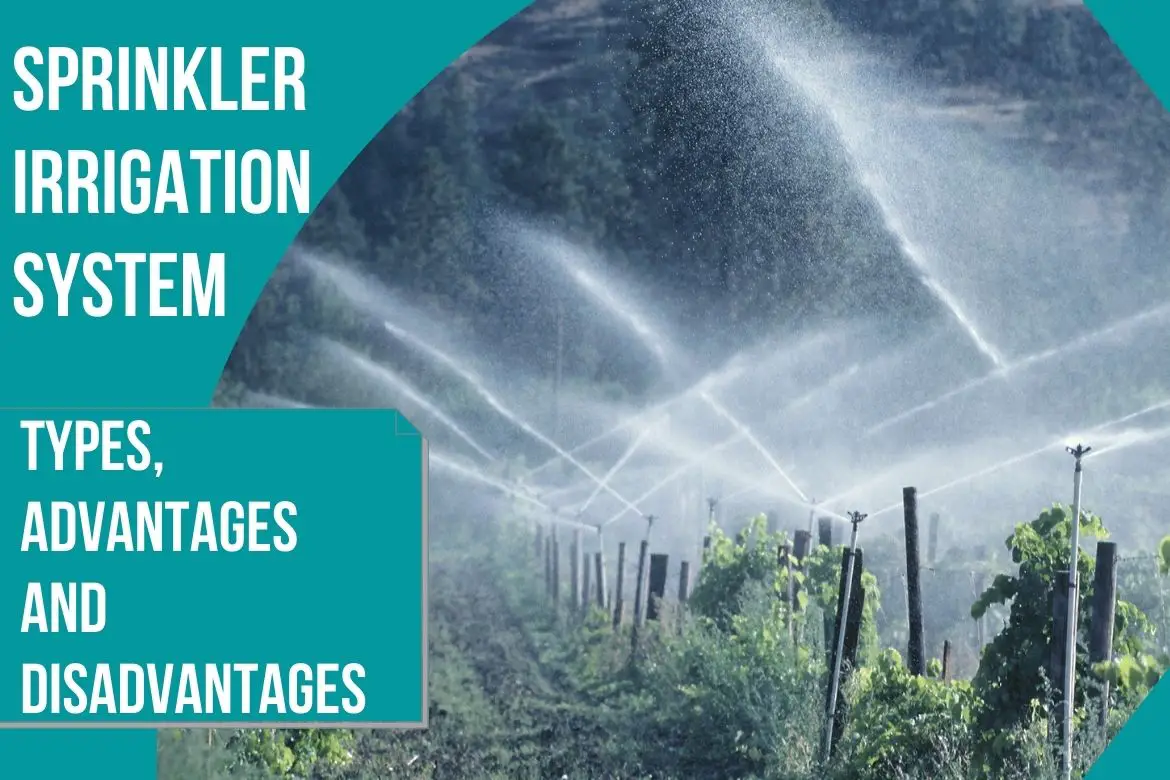
1 comment
thanks for detailed article